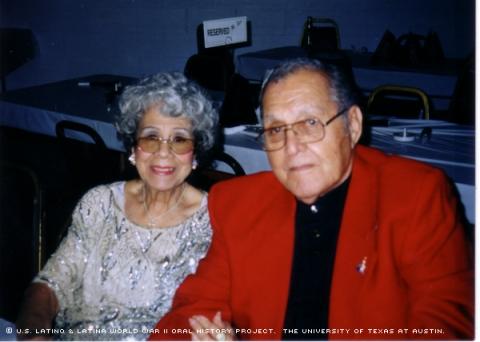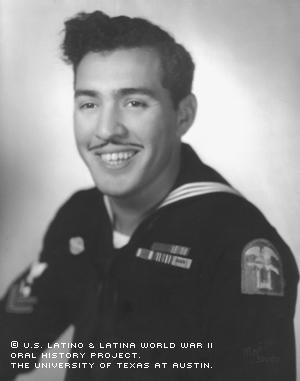

By Rajesh Reddy
George Salmerón grew up hearing how his father was forced to serve in the Mexican Army at age 13 in the early 1900s.
"[My father] saw a bunch of soldiers coming around with a little drum, single-file. All of a sudden, they stopped in front of him. They made a circle completely around him, and they took him off to the Army," Salmerón said. "He was then officially recruited in the Army of Porfirio Diaz."
Later, his father, Pedro Salmerón, and mother, Maria Farela Salmerón, would leave Mexico and settle in Houston, where they’d raise five boys, including George, whom they named after the first president of their adopted country.
The day after the attack on Pearl Harbor, a 17-year-old Salmerón wouldn’t wait to be drafted. He enlisted in the Navy.
On Sundays, the family would often pile into their Ford Model-T and drive to the beaches of nearby Galveston. In the afternoons, they’d return to their neighborhood, where Salmerón vividly remembers a white, two-story café with a sign on the door that read, "No Mexicans or dogs allowed."
Salmerón also recalls a run-down church in Hennessy Park being donated to the city of Houston in 1930. The city divided the park into two halves: the section of the land with the swing set was given to Latinos, while the side with the tennis courts and ball park was designated for Anglos. Salmerón remembers the Anglos' side was where the water fountain was.
"Being a little boy, I went to get a drink of water," Salmerón said. "Before I knew it, someone grabbed me and threw me on top of a blanket and started tossing me around like a little monkey."
Luckily, Salmerón's brother, Alfonso, came to his rescue. Salmerón recalls him standing before the Anglo boys and saying, "You let my brother go. If you don't, I'll beat all of ya'll up."
The boys laughed at Alfonso and starting picking up rocks, Salmerón says, but by that time the rest of the Mexican Americans families who were there had gotten up.
"This is why I love my brother so much," he said.
Salmerón was attending Sunday school at El Mesias Methodist church on Dec. 7, 1941, when he heard of the bombing at Pearl Harbor. At 2 in the afternoon the next day, one of Salmerón’s friends said he’d be enlisting at 3. Salmerón replied, "I'll be there at 3."
"In our neighborhood it wasn't, 'Are you going or not?' The question," Salmerón remembers, "was when."
While waiting in line, a retired chief petty officer helping to organize the line of recruits pulled Salmerón aside. He asked him how his grades were and told him to finish high school and then come back.
Salmerón did just that, and on August 3, 1942, he enlisted in the Navy. At boot camp in San Diego, Calif., Salmerón used many of the skills he’d acquired from being a Boy Scout. At boot camp, he was named team captain of the softball team, and then was chosen as one of three petty officers out of the group of 186 soldiers in August of 1942.
One day, after cleaning a restroom, and right before his group was to undergo inspection, a tall Anglo soldier asked to use the bathroom. Salmerón asked him to use the one down the hall, but the soldier pushed him aside, saying he wasn't going to listen to a “Mexican.”
Enraged, Salmerón tackled him while he was at the urinal and pinned him down. An officer was summoned to respond to the fight and, after the two men were under control, the officer demoted Salmerón from Petty Officer to Apprentice.
But that wasn't the end. Two days later, when he saw the same sailor again, Salmerón attacked him anew.
"First of all, I'm not a Mexican; I'm an American," Salmerón recalled telling him.
He also remembers telling the sailor he’d again attack him the next time they met.
The Anglo sailor apologized and they soon became good friends, Salmerón says.
But the victory came at a hefty price.
"It cost me a whole year's pay as a petty officer," Salmerón said. "It was a bitter lesson to take."
Salmerón was stationed aboard the President Hayes (APA-20) on Feb. 17, 1943, with nearly 60 ships when a Japanese "Betty" -- a heavy bomber used by the Japanese Navy -- flew overhead, taking pictures. Later that night, the Japanese dropped flares to count the American ships. Salmerón was entrusted with the duty of pointing out aircraft coming in. Then, a group of 20 or 30 Kamikazes flew in from the dark horizon.
"Everyone was firing in unison," Salmerón remembers. A second wave descended upon the fleet from another direction. The Americans shot them down, too.
"That was the beginning of the worst night we ever had," Salmerón said. When the morning came and the attack was over, not a single American ship had been sunk, nor had a single American soldier died. The battle was called "the night torpedo action off Mala."
Nearly a month after this battle, Salmerón's ship headed to Fiji Island to pick up Fijian soldiers to help fight in the war. Salmerón remembers the tall, well-built soldiers looking up to one of the Fijian hills as they were loading into the dock. Their families were crowded around a fire.
"The people up in the hills started singing to the people down here," said Salmerón, remembering that when they were done, the soldiers began singing farewell songs back to their families. "I think it was the first time I realized there really was a God."
Salmerón's stay in the Navy was cut short due to a lack of calcium. This condition caused his bones to become frail, which led to his broken right wrist. His brother Alfonso, who was also in the Navy aboard the USS Copperhee, saw that arm was in bad shape and told him to take care of it immediately.
"You took it this far, I'll take it to Japan for you," Alfonso told him.
Salmerón spent the next 10 months recuperating in various hospitals when, in 1945, he went to the University of Houston for four years. In 1950, he earned a BBA in industrial management. However, the job market was flat at that time due to soldiers returning after the war's end.
"Despite the fact that we could all die for our cause," said Salmerón, "we all can't work."
Even after fighting for America, Salmerón says he saw many doors close for him because of his ethnicity. He remembers applying for an industrial engineer opening, but as soon as they saw he was Hispanic, he says they denied him the position.
He also recalls going to a job locator.
"The first thing they did with my application was put in red letters: 'M.E.X.,' " Salmerón said.
He later set up his own remodeling construction business, and married Ofelia Gonzales on Feb. 24, 1946. The Salmeróns have been married 57 years, have two daughters, Flora Marie and Betty Jane, and still live in Houston. Some of Salmerón's WWII honors include a Victory Medal, Navy Unit Citation Medal and Commendation Medal.
Mr. Salmerón was interviewed in Houston, Texas, on April 2, 2003, by Ernest Eguia and Paul R. Zepeda.

